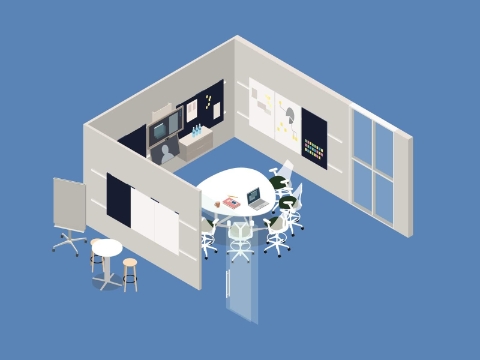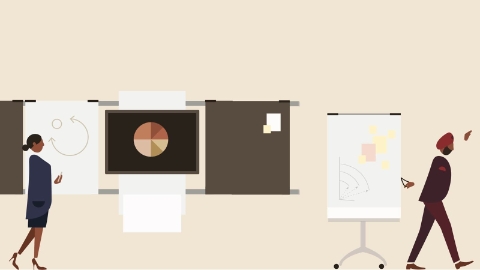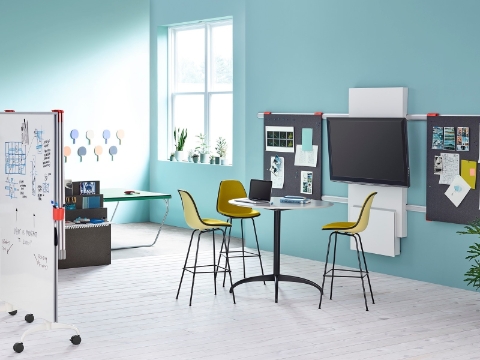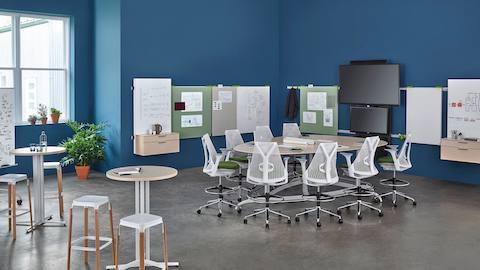Key Insights
- Organizations today rely on collaborative teams for the innovation that fuels profitability, but struggle to provide work environments that help their people work and think together.
- The workplace can enhance collaboration by optimizing social interaction, through the use of analog as well as digital tools, and by allowing for free movement and postural change.
- A Living Office Workshop addresses these issues to provide an ideal setting for people working together to generate new ideas.
- Exclave is the first cohesive suite of products to comprehensively address collaboration in today’s workplace.
For years, business leaders have understood that teamwork improves corporate success. More than a decade ago, nearly 80 percent of senior executives surveyed were already indicating that effective collaboration was crucial for growth.1 Today, the stakes are even higher.
More and more organizations rely on the innovative thinking of their high-performing teams. But leaders struggle to create workplace environments that help people think and work together. “Collaboration is the way we work now,” writes Stern School of Business Professor Anat Lechner. “Unfortunately, our legacy work environments—dominated by offices or cubes—rarely match this new reality.”2
Regarding the physical environment, cognitive psychology offers new insights. Recent studies consider the effects of the physical environment on the ways groups of people interact with information and each other to solve complex problems and generate new ideas. For example, the concept of “distributed cognition” suggests that thinking happens not only in individual minds, but is a process that is “distributed” among groups of minds as well as the places where they come together and the tools they use.3
Communication Rules
Humans evolved as social creatures, hardwired to seek out meaningful connections with each other. Communication builds a sense of belonging, one of the fundamental human needs we all share. Design that understands why and how people interact with each other can foster connection and trust—and galvanize group collaboration.
Researchers comparing “high-performing” and “poorly performing” teams across a variety of industries found that the way team members interact was the single most important predictor of team success. Data showed that the interactions of high-performing teams shared these defining characteristics:
1. Everyone on the team talks and listens in roughly equal measure, keeping contributions short and sweet.
2. Members face one another, and their conversations and gestures are energetic.
3. Members connect directly with one another—not just with the team leader.
4. Members carry on back-channel or side conversations within the team.
5. Members periodically break, go exploring outside the team, and bring information back.4
The study also found in-person communication to be highly valuable, noting that “35% of the variation in a team’s performance can be accounted for simply by the number of face-to-face exchanges among team members.”5
Tangible Interaction Counts
Although most research regarding tools used for collaboration focuses on the electronic devices, groupware, and social media that teams use to share information and develop and document ideas, recent studies have begun to look at how teams use analog materials (whiteboards and markers, sticky notes and pens, sketch pads and pencils) to support group thought processes. For instance, researchers observing innovation teams at work found a preference for analog tools over digital, pointing toward “a general need for tangible tools in the creative work process.”6
Experts increasingly agree that “tangible interaction” with physical objects adds an important dimension to any type of collaboration that requires “the collective construction of new shared understandings.”7 Work environments designed to “enable new value creation through collaboration” must provide analog tools “like whiteboards that allow employees to record ideas and create a visual, side-by-side review of alternative solutions. Such tools are key enablers helping groups reach a shared understanding faster and more effectively.”8
Movement Matters
Much of the research regarding the effects of physical space on collaboration comes from the designers of virtual spaces for computer-supported cooperative work (CSCW). In order to understand the needs of teams collaborating via digital interfaces, CSCW researchers study the way co-located teams move about in and interact with their physical surroundings. They have long established the key role the environment plays, as in the field study that found the space itself enabled communication by allowing people to move and to observe each other’s movements “as they talked together and made and used various artifacts within the shared physical workplace.”9
Another study focusing on posture and movement found that groups working together while standing were “measurably more engaged” than while seated. Researchers concluded that “a workspace that encourages people to stand up is going to lead to more collaborative and more creative outputs.”10

Applying Understanding to Space Planning
A deep understanding of people, the work they do, and the tools and furnishings they need to succeed informs Herman Miller’s Living Office approach to workplace design. This framework provides a range of possibilities for translating insights on how people gather to solve complex problems and generate big ideas into settings that enhance this work. Among these, the Workshop Setting is particularly suited.
The Workshop Setting influences team communication patterns by ensuring that individuals can always see and hear each other easily—even when participating virtually. Careful attention to sightlines supports the face-to-face interactions that are so essential to building trust and a sense of belonging. Purposeful placement of videoconferencing cameras and displays give virtual participants a seat at the table and the ability to make eye contact with fellow team members onsite.
Ample circulation space encourages movement around the space, making it easy for people to interact with tools and with each other. Mobile furnishings let teams arrange the physical space to support different activities. For example, different sized tables can be grouped together for team discussion and ideation, then relocated to let team members spread out and work on their pieces of a larger project.

Exclave: A Comprehensive Approach to Collaboration
Among the product solutions Herman Miller provides to support collaboration, Exclave is particularly appropriate. Exclave is the first cohesive suite of products to comprehensively address collaboration in today’s workplace. Based on the concept of distributed thinking, Exclave equips space to help people develop and share ideas more fluidly and spontaneously, throughout the day, across the office.
In a Workshop Setting, Exclave supports the cocreation of new ideas and content among team members with products that work together to optimize communication, stimulate energizing movement, and promote the collaborative use of digital and analog tools.
In contrast to the rectangular tables that typically furnish conference rooms, the guitar pick and tear drop shapes of Exclave tables maximize face-to-face communication among all participants. At seated or collaborative standing heights, team members can assemble around the table without blocking anyone’s view of anyone else, encouraging equal participation in discussions and direct connections between individual team members. To give remote participants a “seat at the table,” Exclave positions videoconferencing equipment at eye level. With shared electronic displays located above and below, onsite participants can view both without turning away from the camera—a movement that can be disruptive to remote participants’ experience of social connection. Mobile carts and lightweight boards can be quickly positioned within camera range so that remote team members can also view analog tools as they are used and discussed.
A collaborative standing-height version of the table sets the scene for dynamic interaction. In addition to supporting stand-up meetings that improve team energy and engagement, collaborative standing-height tables with ergonomic foot rings paired with stools keep all participants—sitting or standing, remote or onsite—at eye level. And perched or standing team members are free to interact more spontaneously with surrounding tools like whiteboards, without requiring the abrupt posture change that can inhibit participation.

Exclave’s rail and board system uniquely supports the use of hands-on, tangible tools that augment collective ideation. Lightweight, interchangeable whiteboards, tack boards, and eco boards are easily integrated into both open and enclosed team environments. Rails support quick and easy repositioning of boards to allow teams to develop, express, and modify ideas in a familiar, fluid, and extemporaneous fashion. Because the boards may be stacked up to four deep on the wall, different teams can share the same rail-equipped space without disturbing each other’s work.
To keep people and ideas moving, Exclave carts transport boards from group work sessions in formal project or meeting rooms to rails installed on walls in open and informal gathering spots like Coves—compact spaces nearby that enable people to assemble and engage with each other for a short period of time. Where rails aren’t available, the carts themselves serve as freestanding support for boards to share ideas and information in the moment. When members go “exploring” beyond the team, portable Exclave boards can go with them, to share ideas for tweaking or problems for troubleshooting.
Based on a deep understanding of the ways collaborative thought is distributed among groups of minds as well as the tools they use and the places where they interact, Exclave helps people participate more fully in the process of solving problems and generating ideas. To learn more, please visit hermanmiller.com/exclave.
1. Lechner, Anat. "Better Teamwork Through Better Workplace Design," Harvard Business Review, April 18, 2012. https://hbr.org/2012/04/better-teamwork-through-office
2. Cross, R. et al. "Mapping the value of employee collaboration," McKinsey Quarterly, August 2006. http://www.mckinsey.com/business-functions/organization/our-insights/mapping-the-value-of-employee-collaboration
3. Perry, Mark. "Process, representation and taskworld. Distributed cognition and the organisation of information." Exploring the Contexts of Information Behavior, Taylor Graham Publishing, 1999. http://www.brunel.ac.uk/~cssrmjp/homefiles/selected-publications/ISIC.pdf
4. Pentland, Alex. "The New Science of Building Great Teams," Harvard Business Review, April 2012. https://hbr.org/2012/04/the-new-science-of-building-great-teams
6. Borum, Nanna et al. "The Resilience of Analog Tools in Creative Work Practices." Human-Computer Interaction Part I, Springer International Publishing, 2014. http://link. springer.com/chapter/10.1007%2F978-3-319-07233-3_3
7. Stigliani, Ileana and Davide Ravasi. "Organizing Thoughts and Connecting Brains: Material Practices and the Transition from Individual to Group-Level Prospective Sensemaking," Academy of Management Journal, 2012. https://www.researchgate.net/profile/Davide_Ravasi/publication/259784924_ORGANIZING_THOUGHTS_AND_CONNECTING_BRAINS_MATERIAL_PRACTICES_AND_THE_TRANSITION_FROM_INDIVIDUAL_TO_GROUP-LEVEL_PROSPECTIVE_SENSEMAKING/links/0046352de42be322d2000000.pdf
8. Lechner, Anat. "Better Teamwork Through Better Workplace Design," Harvard Business Review, April 18, 2012. https://hbr.org/2012/04/better-teamwork-through-office
9. Robertson, Toni. "Cooperative Work and Lived Cognition: a Taxonomy of Embodied Actions." Proceedings of the Fifth European Conference on Computer-Support Cooperative Work, 1997. http://www.ecscw.org/1997/14.pdf
10. Knight, Andrew and Markus Baer. "Get Up, Stand Up: The Effects of a Non-Sedentary Workspace on Information Elaboration and Group Performance. Social Psychology and Personality Science, November 2014. Cited in "Standing meetings may improve group productivity." http://www.reuters.com/article/us-psychology-group-meetings-productivit- idUSKBN0EV29V20140620
